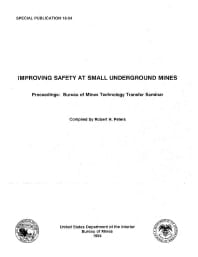Mining Publication: Statistical Profile of Accidents at Small Underground Coal Mines
Original creation date: January 1994
Authors: RH Peters, BA Fotta
NIOSHTIC2 Number: 10005494
In: Peters RH, ed. Improving Safety at Small Underground Mines. United States Department of the Interior, Bureau of Mines SP 18-94, 1994; :5-14
The U.S. Bureau of Mines prepared this paper to provide statistical information on accidents, production, and employment at small U.S. underground coal mines. Mines are categorized according to size as follows: fewer than 20 employees, 20 to 50 employees, 50 to 100 employees, and more than 100 employees. For each size category, statistics are presented showing the following: (1) the number of mines and the States in which they are located; (2) changes in employment, production, and rates of fatal and permanently disabling accidents between two periods (1978-80 and 1989-91); and (3) rates of coal production and rates of various types of serious accidents. The five States with the largest number of small underground coal mines are Kentucky, West Virginia, Virginia, Pennsylvania, and Tennessee. Statistics are presented to show how various sizes of mines in these 5 States compare with one another in terms of safety and productivity. Statistics are also presented showing how miners who are injured while working at mines of various sizes compare in terms of age and experience. Several propositions about why small mines have higher fatality rates are reviewed.

NIOSHTIC2 Number: 10005494
In: Peters RH, ed. Improving Safety at Small Underground Mines. United States Department of the Interior, Bureau of Mines SP 18-94, 1994; :5-14
- Analysis of Roof Bolt Systems
- Elastic and Shear Moduli of Coal Measure Rocks Derived from Basic Well Logs Using Fractal Statistics and Radial Basis Functions
- Electromagnetic Noise in Itmann Mine
- Electromagnetic Noise in Lucky Friday Mine
- Electromagnetic Noise in McElroy Mine
- Emergency Response Planning for Small Mines: Who Needs It?
- Ergonomic and Statistical Assessment of Safety in Deep-Cut Mines
- A Feasibility Study for the Detection of Weak Electromagnetic Signal/ Bursts With Hard-Limited Arrays
- Peak Methane Concentrations During Coal Mining: An Analysis
- Time and Amplitude Statistics for Electromagnetic Noise in Mines